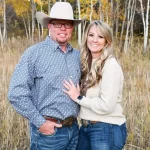At this time of year, the ranchers around here have bulls on the brain. There is a lot of prep work to be done before we turn the bulls out for another summer.
I have to throw this out there that I am so glad I’m not a cow (for a lot of reasons) because if someone was planning my next pregnancy this close to having my last baby (or if I was about to have a baby) I think I would give them a zap with the hot shot.
Good thing the cows don’t feel this way, because we are getting things geared up out here. One bull will cover (breed) about 25 cows, which means we need about 35 bulls. Choosing and buying new bulls can be pretty intense. The bulls we choose will factor in the end product we have- a good finished steer or a good replacement heifer.
The Rancher, the kids and I loaded up in the truck the other day and headed out to Leadore, Idaho (which happens to be where we met, fell in love, and lived when we were first married!) to find a bull at the Leadore Angus Ranch bull sale.
Before the auction ever starts they give the ranchers time to really look through the bulls. They give out as much information on the bull as possible to help buyers find what they want. In their sale magazine they have the parents of each bull, the bull’s individual performance (which is his birth weight, weaning weight, yearling weight, ect.) and then a list of the expected progeny difference (how they think the calves from this bull will perform).
It’s a lot to take in. In fact, I don’t even know what it all means! I guess that’s why I brought The Rancher… He was looking for a good bull for first time heifers. What he looks for in that jumble of numbers is a bull that will have a low birth weight (it makes calving easier for first time heifers), a high weaning weight (it means they gain weight well), and high milk production (for the heifers we will keep to be mommas later on). PS, did you know that milking traits are paternal, not maternal? Another important bit of info to look at was the CED, calving ease direct. It directly identifies which bulls will lead to easier calving.
Picking out a bull by the numbers is just the first part. Since we are looking to market our calves for meat, we want to produce cuts that have high marbling and a large rib eye (the spot where all of your steaks come out of) surface area. So the next page of numbers we looked at was the results from an ultrasound which gave the bull’s muscle and fat measurements.
After narrowing down the bulls we liked based on the progeny potential and the meat quality potential, it was time to actually go see the bulls. We look for a really fleshy bull, something with a wide backside and a long, deep body. Something that would grow a lot of good meat! We also check out their condition and how well they will make it out on the range. Some of the areas our cattle will go can be pretty intense, so we need a bull that will keep up and get the job done.
The real fun is when the auction gets started. There is all of the bustle of the people, the constant rambling of the auctioneer (I know its not rambling, that’s what it sounds like), the cattle moving in and out, and the ring man taking bids. There is a sort of tension in the air from the buyers trying to bid at just the right time against their competition, the men working the sale trying to get it just right, and the owners trying to have everything just right for a good sale day. I really meant it when I say the auction is the fun part! I love it all!
It was a little more stressful for The Rancher because he was busy trying to get in on those few bulls he really liked without paying a fortune! His patience won out and got him a really nice heifer bull at a good price. All in all, it was another good day for The Rancher and posse!











I would never want to be a cow either! One of my jobs is to run the record when the vet comes to pregnancy check. The guys can't understand why the cows kick. Come on! If someone had their whole arm up "you know", they would kick too!